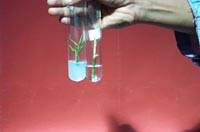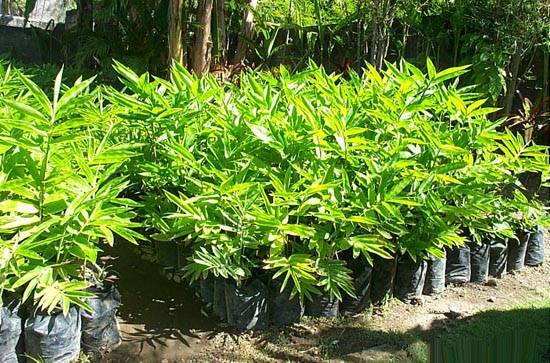CULTURAL PRACTICES OF THORNLESS BAMBOO
INTRODUCTION:
Bamboo is a member of the grass family Graminea and the fastest growing woody plant on the earth. Bamboo is a versatile, strong, renewable and environment friendly material. Bamboo described as the “wood of the poor” in India, “friend of the people” in China and “brother” in Vietnam. Bamboo is a wonder plant that grows over wide areas of Africa, Asia, the Caribbean and Latin America. Millions of people depend on this plant for their livelihood. Its use in food and cooking goes far back in history. Apart from traditional uses, bamboo has many new applications as a substitute for fast depleting wood and as an alternative to more expensive materials.
Woody bamboos have vast economic and as yet substantially untapped potential. Historically woody bamboos have been used for different applications but rather recently interest from paper and wood industries has increased. Bamboo is often advocated as an ideal renewable resource for biomass, useful for wood and paper industry. Positive arguments thus also include ecological arguments; indeed in the future forests and agriculture, water conservation, soil stabilizer, an effective carbon sink and helping to counter the green house effect are very important criteria. However, the classical economic criteria (profit and added value) will remain very important.
MICROPROPAGATION:
Bamboos can be propagated through one of these following methods seeds, rhizome, culm cuttings and clump division. But the efficiency of these propagation methods varies greatly. Bamboo propagation techniques are insufficient, in view of the need for quality planting material at very large scale. To meet increasing demands for bamboo planting material, Growmore Bio Tech Ltd. Developed efficient micro propagation method for mass scale propagation that are commercially viable and that can give added value to those who transform the biomass harvested. In micropropagation, mass scale production of high quality plants, which are easy to transport and deliver on site, disease free and vigorous growers. Moreover micropropagation is very flexible and rapid upscaling is possible. Bamboo balcooa new selection can be produced in large numbers starting from one single plant only. Such short time frames large numbers cannot be rivaled by any conventional method.
 
Micropropagation of Bamboo
Soil |
Most bamboos grow best in deep,well-drained,fertile soils and they generally prefer neutral; to slightly acid soils. |
No. of plants / ac |
200 plants / ac. |
Spacing |
5 x 4 meter |
Season & Planting |
The best planting time is usually as soon as monsoon starts. This gives the plant, a longer growing season to get established and develop its roots to withstand the hot summer season. |
Climate |
Bamboo can be grown in a wide range of environments, requiring well distributed rainfall, with shortfalls being made up through irrigation. Although bamboos are hardy, adaptable and forgiving plants, they are intolerant of waterlogged condition. |
LAND PREPARATION:
The land should be ploughed as thoroughly and deeply as possible. Clearing and ploughing should be done at least three weeks ahead of the planting. Addition of organic materials such as compost, green manures and neutralized saw dust help to retain moisture and also provide nutrition to the plants. Provide better drainage system. Bamboo likes water and requires lots of water to do its best, but it does not like to be submerged in water or “wet feet” condition.
PITS:
Pit sites should be identified before digging the pits, to ensure the desired spacing. Dug the pit (3 x 3 x 2 feet size). Pits should be dug much before the rainy season and the dug out soil exposed to weathering. A few days before planting thoroughly turn the soil in the pit.
PLANTING:
In the pit mix the soil with 10 kgs of FYM or vermicompost, 200gms neemcake 50gms Urea, 50gms Super Phosphate and 50gms Murite of potash. Carefully remove the Polybag using blade, to ensure the root ball not disturbed. Place the plant vertically in the pit, ensuring that the roots do not curl. Level the pit with the mixed and enriched soil, being sure to eliminate all air pockets. Mulch the soil around the plants will help control weeds and keep the soil moist.

IRRIGATION:
Drip irrigation is one of the good irrigation systems to get maximum yield. After planting, irrigate with 12-20litres of water, depending on the prevailing climatic conditions and compact the loose soil around the plant. Repeat the watering the next day. For the next 10 weeks (at daily intervals initially, extending later to once in three days).
FERTILIZER APPLICATION:
Bamboo plants are heavy feeders and respond well to fertilizers, growing more vigorously with fertilizer application than without. Fertilizers are important to ensure high yield and overall profitability of plantations. Bamboo needs complete range of fertilization, including nitrogen, phosphorous and potassium, and often a higher amount of nitrogen. It is better to carry out soil analysis to fix and confirm the dosages. A general dosage norm that may be followed is 15.5kgs of Urea, 5.5kgs of SSP and 13.45kgs of MOP per plant per year. For first year 50%, second year 75% and third year onwards-full dose should be given in 10 split doses. Fertilizer application is required to be done first during planting; the fertilizer should be mixed in the pits. Subsequently, fertilizer should be applied every months of planting. Care should be taken to see that chemical fertilizers are not applied directly.
CLUMP MANAGEMENT:
SOIL LOOSENING:
Soil should be loosened to a depth of 10 – 15 centimeters, and 30 –45 centimeters away from the bamboo clump at least twice a year is improves the growth of shoots and the root system.
WEEDING:
Regular weeding is necessary to prevent weeds and other vegetation from competing with the young bamboo for sustenance. Weeding should be done at least for the first two years after the rains and end of the wet season. Once the clump gets established there is considerable leaf shedding and this acts as a barrier to the emergence of weeds.
MULCHING:
Mulching reduces loss of moisture due to evaporation from the planting pits and checks weed growth. In grownup bamboo field, fallen bamboo leaves serve as good on-site mulching material. Bamboos have a requirement of silica for growth that can also be contributed by bamboo leaf mulch.
MOUNDING:
Rhizomes grow laterally under the soil surface and when ready to throw up shoots, begin to grow upwardly inclined angle as well. In this period of growth, exposure to sunlight retards and may even stop the growth of rhizomes. Mounding or heaping fresh, loose soil around and over the base of the plant is recommended.
PRUNING:
In some species there is heavy branching at the lower nodes of the plant. For example dendrocalamus hamiltonii and bambusa balcooa. Pruning of these branches reduces clump congestion and helps provide a healthy, airy environment within the clump. Mild pruning should be done in the second and third years of growth, and intensive pruning from the fourth year onwards. It should be completed before the end of the dormancy period, well before shoots emerge. Pruning should be carried out in the month of December and January.

Hardening of Bamboo
CLEANING:
Generally clump formation starts in third year, the management of clumps are very important. Rhizomes grow centrifugal (outwards) throwing up new shoots in enlarging circular formation. Bamboos can throw up many branches, which if left unattended can get deeply entangled. This not only curbs access to older culms towards the center of culm, but also obstructs free vertical growth of new culms. The new culms may get twisted and turned, which further congest the clump. Such malformed culms make harvesting of the better culms difficult. Therefore, it is important to clean clumps early and to remove all dead and malformed culms. A well aired clump results in the emergence and growth of healthy culms. Dead stems are not only vulnerable to pathogens, but also dry up fast and are a potential fire hazard.
A good time to carry out clump cleaning operations is February-March. In this period of dormancy after the rigors of winter are over and before the cycle of active growth begins again, the plant system is better prepared to withstand the stress of cleaning activities.
THINNING:
Thinning the clump is essential from third year onwards to avoid congestion and to ensure proper growth and easy extraction of culms. Weak and deformed culms should not be retained in the culm. An appropriate clump structure should be maintained through thinning as well as through extraction or retention of shoots.
HARVESTING:
Harvesting of bamboo culms every year will induces the emergence of new shoots and ensures regular and healthy culm production. Harvesting of bamboo for commercial purpose can begin from the third year of establishing a plantation. However the clump will mature and yield culms of full physical dimensions only after the fourth year.
The age of the culm is an important factor in the use s to which it is put.
- For non structural applications and those that do not require their peak physical and mechanical properties, 2-3 year old culms from a mature clump may be harvested.
- For most purposes however culms should be harvested when they are 4 years old.
- Culms that are more than 5 years old begin to turn brittle and week and then die. As a norm culms over 5 years should not be retained in a commercial plantation.
The best time of the year to harvest culm is in the post monsoon season extending through the winter. This is the period of dormancy during which culms tend to have lower starch content. They are therefore less susceptible to borers, termites and other pests. Culms should not be harvested in the growing season, which is normally during the monsoon months. Harvesting in this period can damage young and emerging shoots and retard the future growth of the clump.
HARVESTING TIPS:
- The number of harvested mature culms should not normally exceed the number of healthy shoots that sprouted and grew into young culms in the preceding year.
- Stunted and diseased shoots should be removed from the clump as soon as they are identified.
- The clump should be visually examined and the clums tobe harvested selected, before beginning cutting operations.
- Adherence to a maturity marking system will facilitate and expedite such selection.
- Branches extending from the lower nodes of the selected culms should be removed. This makes cutting and extraction easier.
- The culm should be harvested at least one, preferably two nodes, above the ground. This reduces the risk of injuring the rhizome.
- The culm should be cut obliquely, that is, with a slated cut. This ensures that rain water, debris and twigs do not collect in the uncut portion above the last remaining node, and become a breeding ground for fungus, parasites and insects.
- The felled culms should not be dragged along the ground to the collection or stacking point. This may injure or scratch their epidermal layer, lowering their value.
Source: GROWMORE BIOTECH LTD., |

